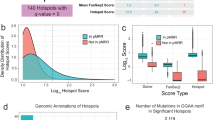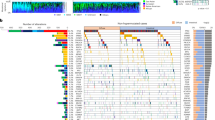Abstract
The incidence of melanoma is increasing more than any other cancer, and knowledge of its genetic alterations is limited. To systematically analyze such alterations, we performed whole-exome sequencing of 14 matched normal and metastatic tumor DNAs. Using stringent criteria, we identified 68 genes that appeared to be somatically mutated at elevated frequency, many of which are not known to be genetically altered in tumors. Most importantly, we discovered that TRRAP harbored a recurrent mutation that clustered in one position (p. Ser722Phe) in 6 out of 167 affected individuals (∼4%), as well as a previously unidentified gene, GRIN2A, which was mutated in 33% of melanoma samples. The nature, pattern and functional evaluation of the TRRAP recurrent mutation suggest that TRRAP functions as an oncogene. Our study provides, to our knowledge, the most comprehensive map of genetic alterations in melanoma to date and suggests that the glutamate signaling pathway is involved in this disease.
This is a preview of subscription content, access via your institution
Access options
Subscribe to this journal
Receive 12 print issues and online access
$209.00 per year
only $17.42 per issue
Buy this article
- Purchase on Springer Link
- Instant access to full article PDF
Prices may be subject to local taxes which are calculated during checkout



Similar content being viewed by others
Accession codes
References
Jemal, A., Siegel, R., Xu, J. & Ward, E. Cancer statistics, 2010. CA Cancer J. Clin. 60, 277–300 (2010).
Davies, H. et al. Mutations of the BRAF gene in human cancer. Nature 417, 949–954 (2002).
Curtin, J.A., Busam, K., Pinkel, D. & Bastian, B.C. Somatic activation of KIT in distinct subtypes of melanoma. J. Clin. Oncol. 24, 4340–4346 (2006).
Prickett, T.D. et al. Analysis of the tyrosine kinome in melanoma reveals recurrent mutations in ERBB4. Nat. Genet. 41, 1127–1132 (2009).
Pleasance, E.D. et al. A comprehensive catalogue of somatic mutations from a human cancer genome. Nature 463, 191–196 (2010).
Gnirke, A. et al. Solution hybrid selection with ultra-long oligonucleotides for massively parallel targeted sequencing. Nat. Biotechnol. 27, 182–189 (2009).
Sjöblom, T. et al. The consensus coding sequences of human breast and colorectal cancers. Science 314, 268–274 (2006).
Greenman, C. et al. Patterns of somatic mutation in human cancer genomes. Nature 446, 153–158 (2007).
Bos, J.L. et al. Prevalence of ras gene mutations in human colorectal cancers. Nature 327, 293–297 (1987).
Samuels, Y. et al. High frequency of mutations of the PIK3CA gene in human cancers. Science 304, 554 (2004).
McMahon, S.B., Van Buskirk, H.A., Dugan, K.A., Copeland, T.D. & Cole, M.D. The novel ATM-related protein TRRAP is an essential cofactor for the c-Myc and E2F oncoproteins. Cell 94, 363–374 (1998).
Barlev, N.A. et al. Acetylation of p53 activates transcription through recruitment of coactivators/histone acetyltransferases. Mol. Cell 8, 1243–1254 (2001).
Herceg, Z. et al. Disruption of Trrap causes early embryonic lethality and defects in cell cycle progression. Nat. Genet. 29, 206–211 (2001).
Johnson, J.W. & Ascher, P. Glycine potentiates the NMDA response in cultured mouse brain neurons. Nature 325, 529–531 (1987).
Vogelstein, B. & Kinzler, K.W. Cancer genes and the pathways they control. Nat. Med. 10, 789–799 (2004).
Hollmann, M. & Heinemann, S. Cloned glutamate receptors. Annu. Rev. Neurosci. 17, 31–108 (1994).
Pin, J.P., Gomeza, J., Joly, C. & Bockaert, J. The metabotropic glutamate receptors: their second intracellular loop plays a critical role in the G-protein coupling specificity. Biochem. Soc. Trans. 23, 91–96 (1995).
Anton, E.S. et al. Receptor tyrosine kinase ErbB4 modulates neuroblast migration and placement in the adult forebrain. Nat. Neurosci. 7, 1319–1328 (2004).
Rieff, H.I. et al. Neuregulin induces GABA(A) receptor subunit expression and neurite outgrowth in cerebellar granule cells. J. Neurosci. 19, 10757–10766 (1999).
Ozaki, M., Sasner, M., Yano, R., Lu, H.S. & Buonanno, A. Neuregulin-β induces expression of an NMDA-receptor subunit. Nature 390, 691–694 (1997).
Dalva, M.B. et al. EphB receptors interact with NMDA receptors and regulate excitatory synapse formation. Cell 103, 945–956 (2000).
Takano, T. et al. Glutamate release promotes growth of malignant gliomas. Nat. Med. 7, 1010–1015 (2001).
Pollock, P.M. et al. Melanoma mouse model implicates metabotropic glutamate signaling in melanocytic neoplasia. Nat. Genet. 34, 108–112 (2003).
Shin, S.S. et al. Oncogenic activities of metabotropic glutamate receptor 1 (Grm1) in melanocyte transformation. Pigment Cell Melanoma Res. 21, 368–378 (2008).
Rzeski, W., Turski, L. & Ikonomidou, C. Glutamate antagonists limit tumor growth. Proc. Natl. Acad. Sci. USA 98, 6372–6377 (2001).
Palavalli, L.H. et al. Analysis of the matrix metalloproteinase family reveals that MMP8 is often mutated in melanoma. Nat. Genet. 41, 518–520 (2009).
Morente, M.M. et al. TuBaFrost 2: standardising tissue collection and quality control procedures for a European virtual frozen tissue bank network. Eur. J. Cancer 42, 2684–2691 (2006).
Davies, M.A. et al. Integrated molecular and clinical analysis of AKT activation in metastatic melanoma. Clin. Cancer Res. 15, 7538–7546 (2009).
Teer, J.K. et al. Systematic comparison of three genomic enrichment methods for massively parallel DNA sequencing. Genome Res. 20, 1420–1431 (2010).
Biesecker, L.G. et al. The ClinSeq Project: piloting large-scale genome sequencing for research in genomic medicine. Genome Res. 19, 1665–1674 (2009).
Acknowledgements
We thank V. Maduro, H. Abaan, P. Cruz and J. Mullikin for generating the sequence data analyzed here. We thank V.G. Prieto for pathologic review of the biospecimens from MelCore at MD Anderson. We thank T. Wolfsberg for bioinformatics help and J. Fekecs and D. Leja for graphical assistance. This work was supported by the Intramural Research Programs of the National Human Genome Research Institute, the National Cancer Institute, National Institutes of Health, USA and The University of Texas MD Anderson Cancer Center Melanoma SPORE (P50 CA93459).
Author information
Authors and Affiliations
Consortia
Contributions
X.W., V.W., J.C.L., J.K.T., T.D.P. and Y.S. designed the study; K.S.-H., M.A.D., J.E.G., W.R., S.R. and S.A.R. collected and analyzed the melanoma samples; X.W., J.K.T., J.G., J.C.L., S.D. and the NISC Comparative Sequencing Program analyzed the genetic data; V.W. and T.D.P. performed and analyzed the functional data. All authors contributed to the final version of the paper.
Corresponding author
Ethics declarations
Competing interests
The authors declare no competing financial interests.
Supplementary information
Supplementary Text and Figures
Supplementary Figures 1–7, Supplementary Tables 4–9 and Supplementary Note. (PDF 938 kb)
Supplementary Table 1
Score cutoff for determination of melanoma somatic mutations (XLS 39 kb)
Supplementary Table 2
Somatic mutations identified in the Discovery Screen (XLS 1087 kb)
Supplementary Table 3
Significance of the observed mutation rate over the expected mutation rate (XLS 407 kb)
Rights and permissions
About this article
Cite this article
Wei, X., Walia, V., Lin, J. et al. Exome sequencing identifies GRIN2A as frequently mutated in melanoma. Nat Genet 43, 442–446 (2011). https://doi.org/10.1038/ng.810
Received:
Accepted:
Published:
Issue Date:
DOI: https://doi.org/10.1038/ng.810
This article is cited by
-
GRIN2A mutation is a novel indicator of stratifying beneficiaries of immune checkpoint inhibitors in multiple cancers
Cancer Gene Therapy (2024)
-
Whole-exome sequencing of BRCA-negative breast cancer patients and case–control analyses identify variants associated with breast cancer susceptibility
Human Genomics (2022)
-
Whole-genome sequencing reveals novel ethnicity-specific rare variants associated with Alzheimer’s disease
Molecular Psychiatry (2022)
-
Paraneoplastic Autoimmune Neurological Syndromes and the Role of Immune Checkpoint Inhibitors
Neurotherapeutics (2022)
-
Structure of the human SAGA coactivator complex
Nature Structural & Molecular Biology (2021)



